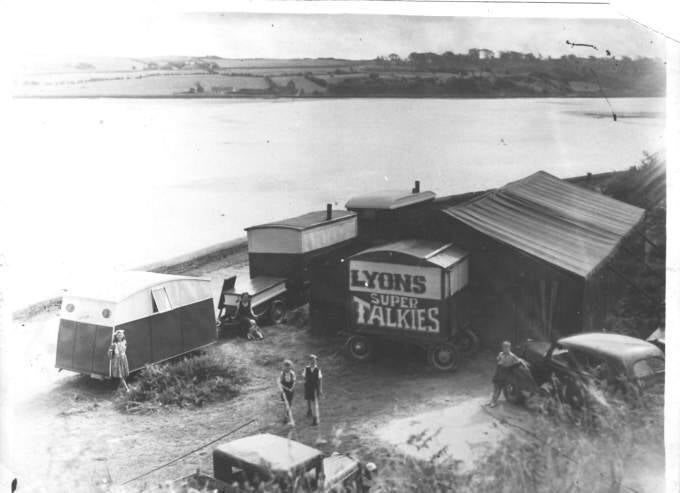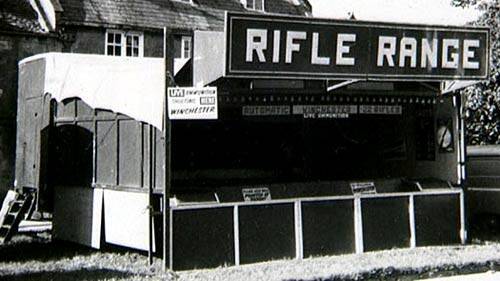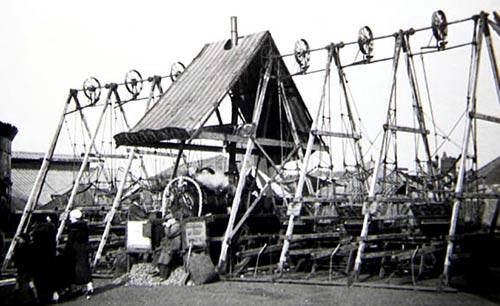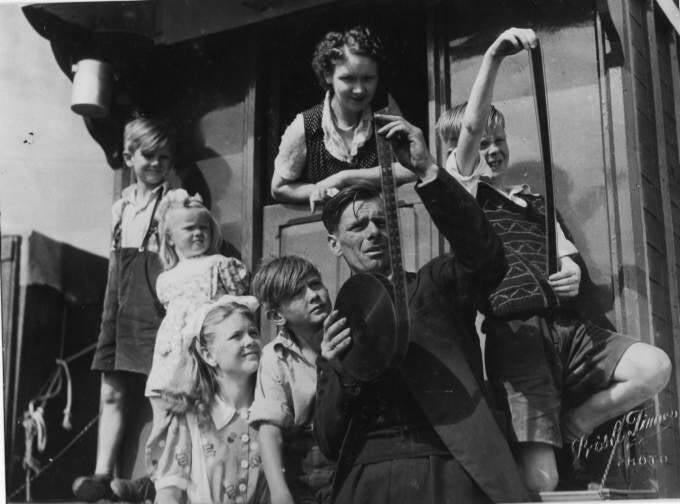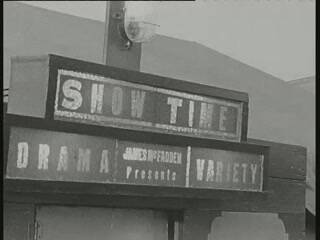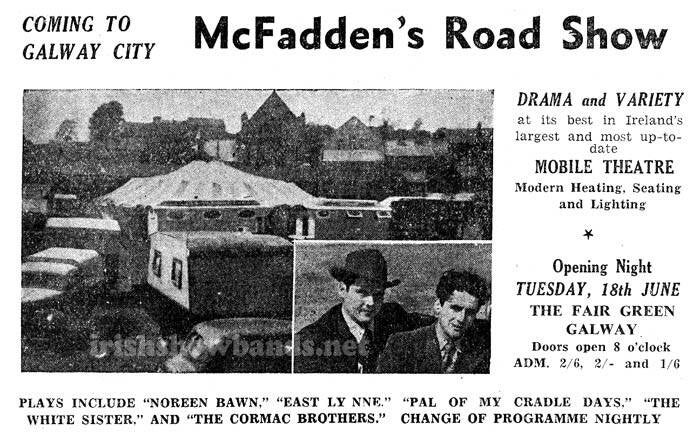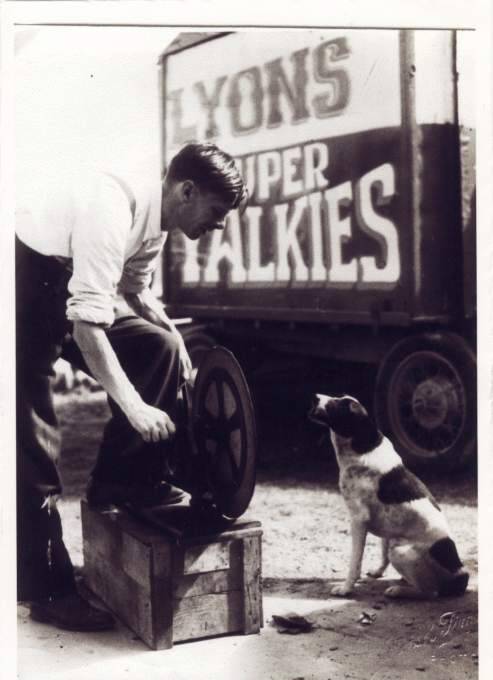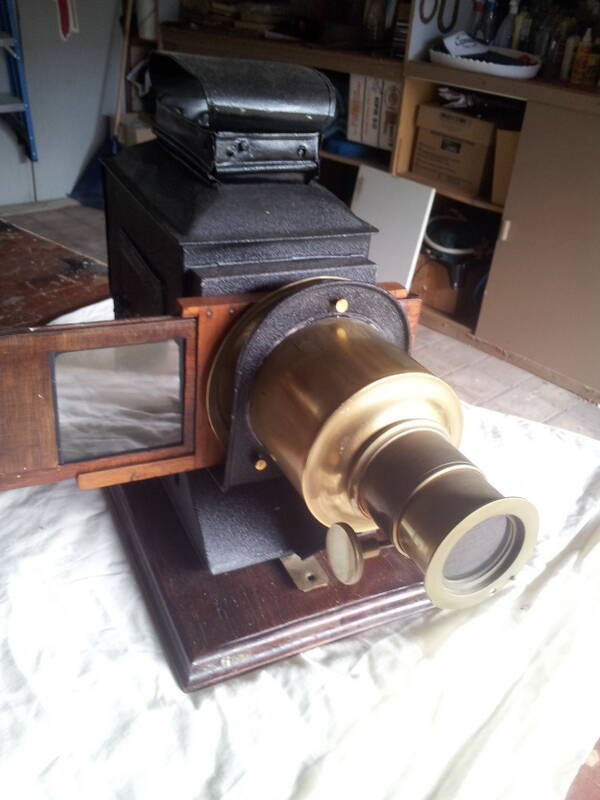Travelling Roadshows & Fit-Ups, that visited Skehana regularly
An early memory of the 1960s were the travelling roadshows that travelled the countryside and arrived generally to the same locations in every parish usually every year or so. They would arrive unannounced in Skehana at an open site that was about 50 yards from my home house at about 8.00am, move in their mobile homes, set up a large tent and other accompanying side shows like swinging boats, a rifle range (strictly for adults only), or bumping cars. Some would have a large closed in trailer that would house a generator while others would have the ESB arrive by the afternoon to give them a temporary connection. It’s funny how they could arrive in Skehana at about 8.00 am and have the ESB connected to the site by 3.00 or 4.00 in the afternoon while today, such an operation would take weeks if not indeed months to install such a service.
Anyway, by about 8.00 pm or 9.00 pm they would be ready to put on the first show with doors opening at 7.30pm. This usually began with the showing of a black and white film, followed by a short play, usually two acts with a raffle during the interval. I can remember well that the Lyons Family used to have six prizes in six boxes and if you had the winning ticket you picked a box. One would contain a booby prize and I can remember one night when Patrick Commins was presented with his prize – a baby’s dummy teat “Jesus what the hell would I be doin’ with a yoke like that” was what we heard all around the tent followed by laughter and applause!
There was a time when the travelling roadshow or fit-ups were an integral part of the theatrical scene in Ireland and Britain. For over a century, travelling companies visited small towns, villages, rural communities that had no established theatres of their own, bringing Shakespeare, melodrama, pantomime and circus (as well as a touch of glamour, glitter and excitement) to people who would otherwise never have had the opportunity to enjoy live shows. Some English companies came over to Ireland, but we had our own great names too, like Anew McMaster (the young Harold Pinter learned a lot of his craft in the McMaster company), The Carrickford Family Roadshow – Robert Carrickford who played Stephen Brennan in Glenroe, John Cowley (Tom Riordan on TV), Annie D’Alton (John Crowley’s wife in real life and Minnie Brennan on ‘The Riordans’), Louis D’Alton, Mícheál MacLíammóir and Hilton Edwards all ascended to the world of Theatre and TV from the fit-up shows. Today, alas, only the circus continues to tour. Fit-ups more or less died out in Britain with the dawn of the 20th century, and the establishment of permanent theatres in all major towns. They hung on in rural Ireland a lot longer, but we saw the last of the great Irish companies on the road in the 1960s. The coming of television had finally killed off the travelling troupers.
During the years of the travelling road show, the shows were never really heavily promoted when a car with a loudspeaker on the roof went around the villages during the day to let people know that it was show time again and the word spread quickly throughout the outside villages and outlying areas also that the ‘show crowd’ had arrived. People met each other on the roads as they travelled on bicycles, at the local shops, chatted at the local water pump or well so news spread quiet quickly in this way. As a result of this intense local communication and word of mouth even on that first day, the opening night, a large crowd would be present. Local communities were starved for entertainment in those years as television was not available to the masses and even though radio was available, it was not in every house. Even then you had only one Irish station, Radio Eireann. The station opened at 8.00am but only ran until 10.00am. It then closed until 1.00pm, opened for a short time and closed again from 3.00pm until 5.00pm when it re-commenced broadcasting until 11.00pm before finally closing down for the night. The music played was mainly classical, the majority of the content was not suited towards country folk so people usually just turned it on for the news. Digressing a little here for a moment there was a very popular programme on radio at the time called ‘Take the floor’ presented by Din Joe (Denis Fitzgibbon) which was Irish dancing on radio! All you heard was music in the background with feet tapping the floor as the guest artists danced the reels and jigs. Hard to believe that Irish dancing on radio was a big attraction. One other little thing I noticed in the 1960s was that if a priest died, in any parish in the country, it was announced on the radio news bulletins at 6.30pm and at 10.00pm at a minimum. I can remember when our PP, Canon Loftus died in Menlough, it was announced on the Friday news at 1.30pm, 6.30pm and 10.00pm, together with a short resume of his life as a priest.
So the travelling roadshow was a very important part of Irish life, Irish culture and a welcome diversion and an uplifting and fun experience to people in remote communities whose only outing each week may be to Sunday mass, the local shop and a few pints in the local pub for the men folk. The roadshows were usually family owned and run. While the usual show was a film and play some shows would run added extras such as a local talent competition for singers, dancers and local musicians. I remember also seeing a rifle range at one show while another popular feature were the swinging boats. There were also some gaming machines in the tent but it was by no means what one would class as gambling.
Once I remember the Hayes Travelling Show doing a sketch to the soundtrack of the Jimmy Kennedy song, ‘South Of The Border’. It was done against a completely dark set, in the darkness and both Frank Hayes and his sister, Martha, wore black costumes trimmed with luminous material, studs, sequences and buttons all coated with phosphorus, with similar headgear. All of the trim on the garments was phosphorus coated also and glowed in the dark. The act went down a storm. First, the song was popular as it was banned on radio because of its storyline, (a man and a girl who was about to join the nuns falling in love). Songs in those days were banned for little or no reason at all. The audience were also seeing something that was ghost like in appearance and magical for its time. For the rest of the two weeks or so while they were on location, people came in their droves from far and near to see the magical dance portraying the man and nun falling in love. The Hayes family then left for Kilkee which was their usual routine each year.
Other families who travelled with their shows to this area in my memory were The McFaddens, The McCormacks, The Lyons family, The second last show I remember was the Hayes family and then the Mullins family being the very last one to ever arrive in Skehana. They did about 11 days in October 1967. Television had arrived and the magic lantern of the Travelling Roadshow was dimming.
Please continue to scroll through the pages above where you will be treated to clips of documentaries in addition to stories as told through the lens of owners and performers of the travelling roadshows. Please leave your comments which we will add to the side in due course
Gerry Costello

My name is Gerry Costello and it all began with a simple idea fueled by a deep passion for keeping the memories ot the travelling roadshows and fit-ups alive and giving them a place in Irish History. This is a small personal project and much of what you will see here is available in fragmented sections throughout the web and the internet. My idea is to try to take as much of the material as possible that is out there and integrate with the research and articles that I have uploaded over the years. Then my aim is to make the information collected available in one place in a format that will be easy to locate, find, read and digest.
I am based in Galway, Ireland, and pride myself on personal research and dedication to every detail in as best a capacity as I can. My approach is rooted in quality and integrity, ensuring that everything I do reflects a commitment to excellence.
Here's hoping you will find the site useful, enjoyable and helpful and thank you for taking the time to visit. Do drop in again as this site will be updated regularly.
Gerry
